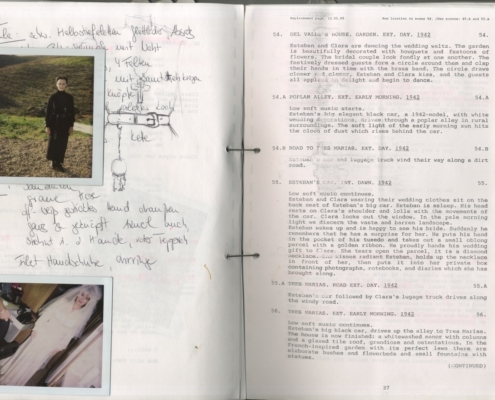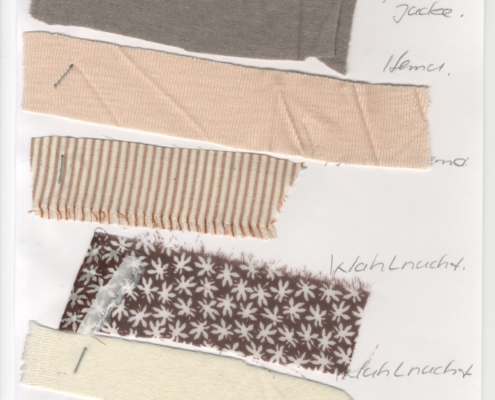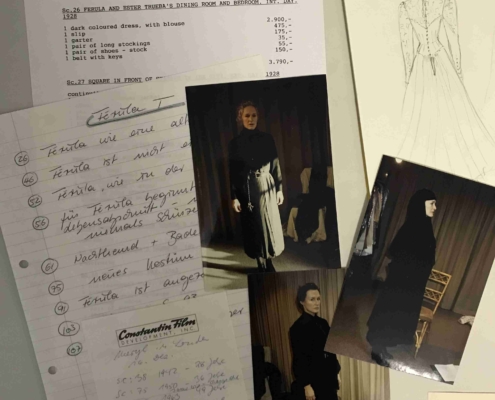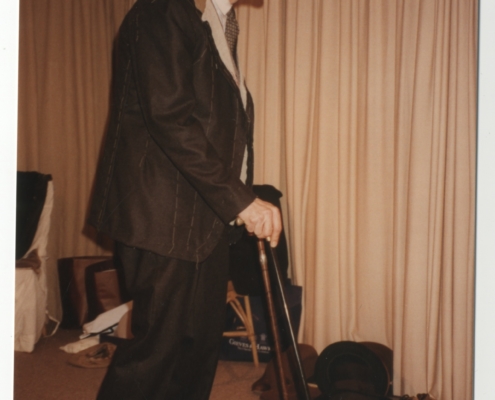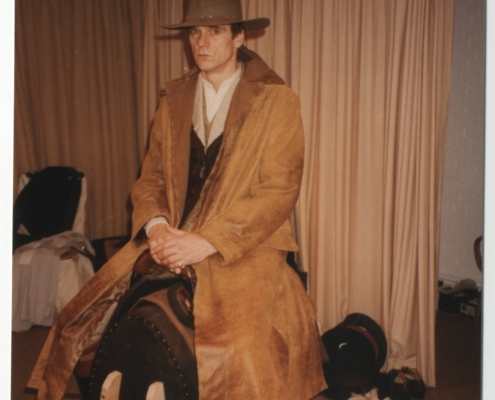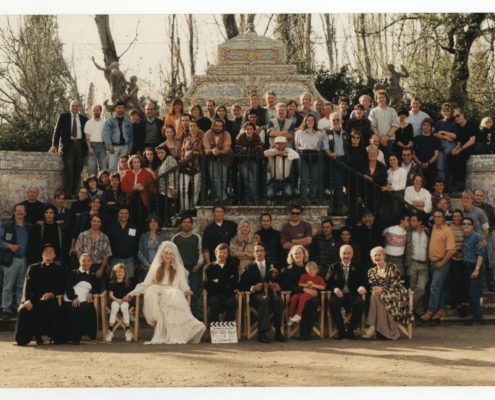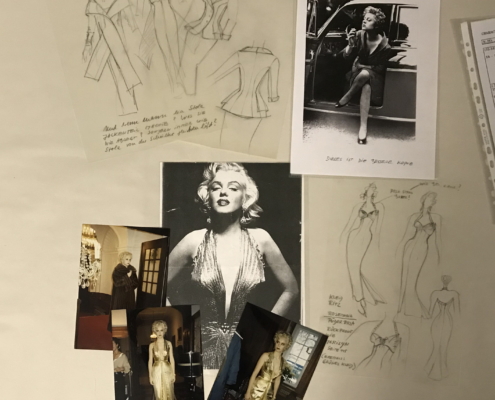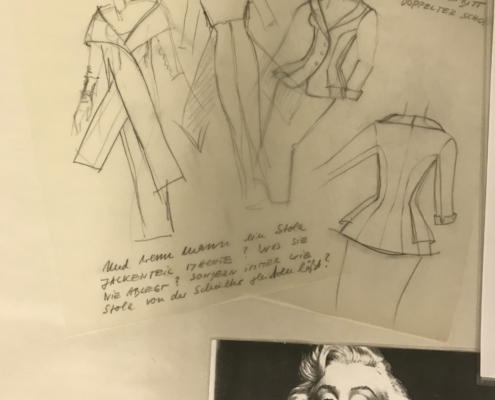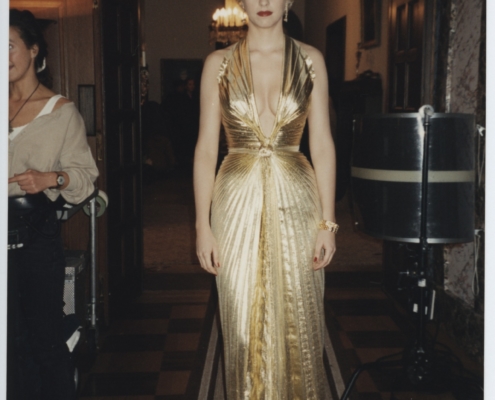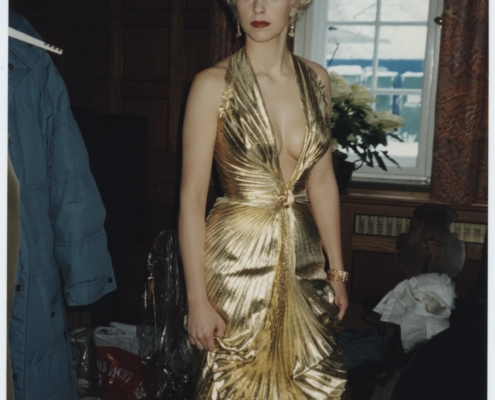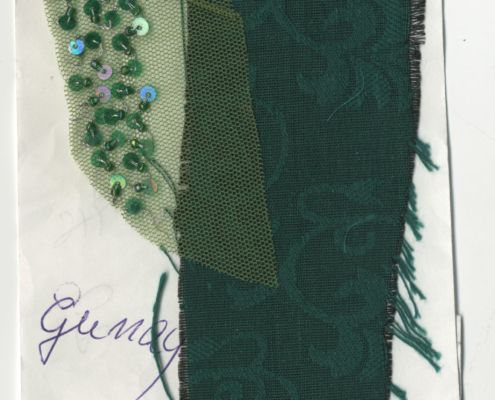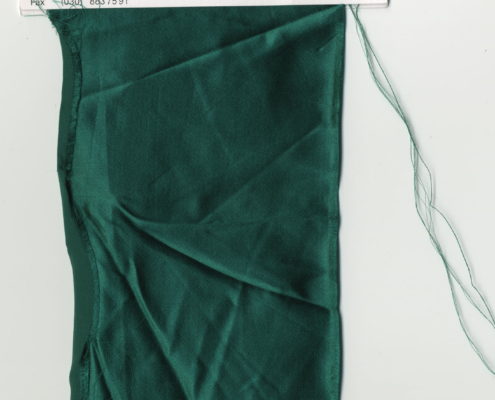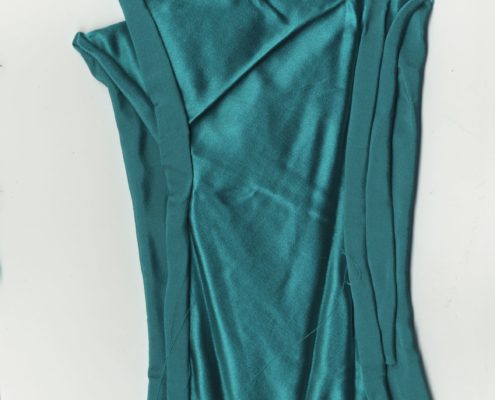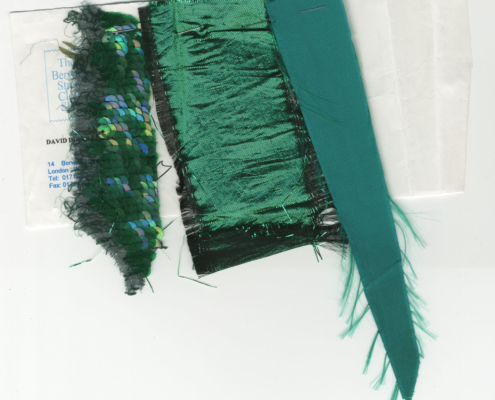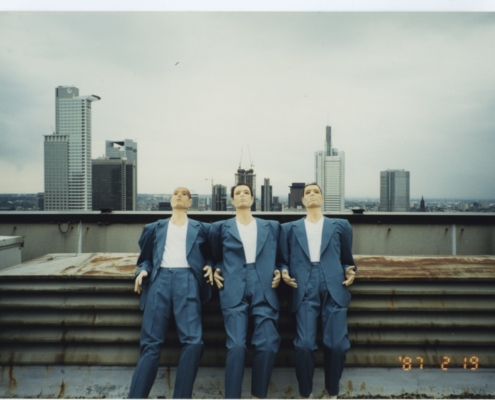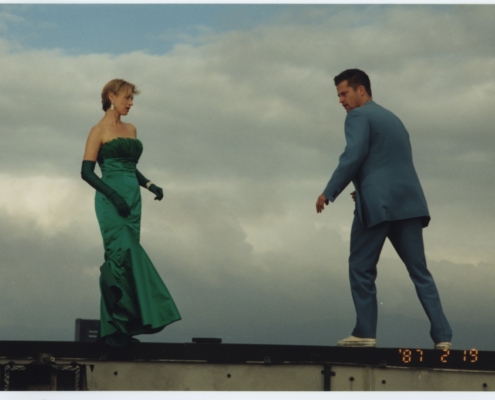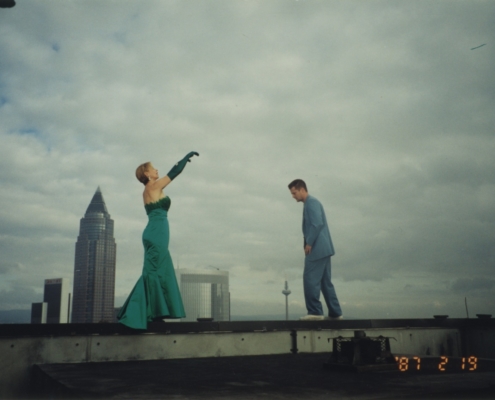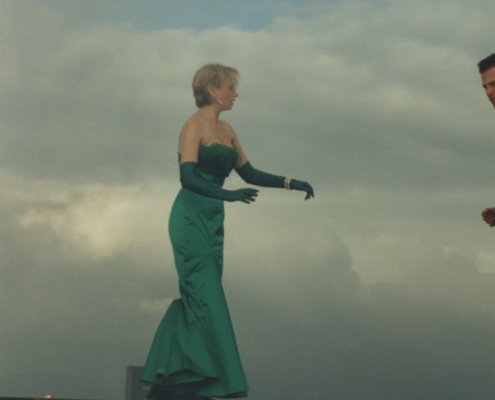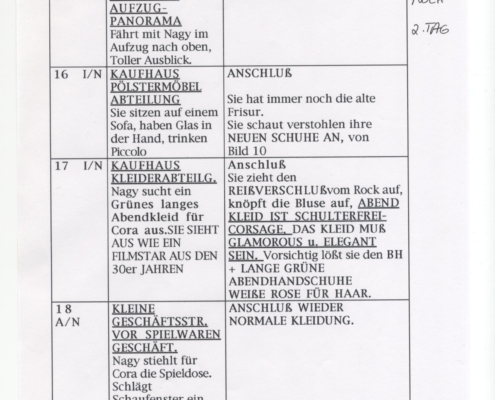This display case shows examples of Barbara Baum’s costume work for the movies The House of the Spirits, A Girl Called Rosemary, and The Devil and Ms. D.
First, some background information on The House of the Spirits. This movie adaptation of Isabel Allende’s biographical epic recounts the fate of the Chilean Trueba family spanning three generations. The movie’s cast includes Vanessa Redgrave, Winona Ryder, Glenn Close, Meryl Streep and Jeremy Irons. Baum’s costumes were made in London and Berlin and reflect fashion trends from the 1920s through to the 1970s.
Work material for the movie is displayed in the left-hand section of the long display case. In the center of the display sits an open sketchpad showing four sketches for the design of the wedding dress worn by Meryl Streep in her role as Clara. A black-and-white photograph shows a historical wedding dress, the long train draped around the bride’s feet. In the upper left corner of the display case is Babara Baum’s open copy of the screenplay, featuring sketches, Polaroids of the costumes, and handwritten notes. Attached to an A4 sheet of paper are six fabric samples for the costumes of Blanca, played by Winona Ryder. Next to this is a handwritten costume plot for Clara and a piece of lace for the veil of her wedding dress. Also displayed are fabric samples in gray, gray-blue and brown for the costumes of Esteban Trueba, played by Jeremy Irons, as well as photos of the actor’s fitting in London and Esteban’s costume list. Below the sketchpad is a costume list and handwritten costume plot for the character of Ferula, played by Glenn Close. Attached to this are three photos of the fitting. A team photo from the set shows director Bille August standing between Meryl Streep and Jeremy Irons, alongside many more of the movie’s cast and crew.
In the middle of the display case is material used for the movie A Girl Called Rosemary – a remake of Rolf Thiele’s 1958 movie adaptation of a true story. In Bernd Eichinger’s first directorial work, Nina Hoss plays Rosemary Nitribitt – a woman who tried to make big money as a luxury call girl in Frankfurt in the 1950s and paid a high price as a result. For the leading actress, Barbara Baum designed figure-hugging garments in the new fashion of the 1950s. One of the costume designer’s film history muses for this character was style icon Marilyn Monroe.
A black-and-white photo of Monroe from the 1953 movie Gentlemen Prefer Blondes forms the focal point of this display. The photograph is a portrait of the actress from the head to the hip. She wears a shimmering, elegant halter-neck dress with a deep V-neck that reaches down to the waist. Monroe gazes into the camera seductively. Above and to the left of this photo are sketches for a woman’s suit – a straight-cut knee-length skirt and a very narrow-waisted blazer – drawn here with a deep neckline. To the right of this is a copy of a black-and-white photo of the real Rosemary Nitribitt. It shows her sitting sideways in the driver’s seat of a car, leaning forward with her left leg crossed over the right – a cigarette in hand. Her outfit resembles the suit in the sketch. Below the photo are sketches of a pink “Ritz” dress for Rosemary. This floor-length halter-neck dress hugs the figure and emphasizes the narrow waist. The sketches are accompanied by handwritten notes. Also arranged around the Marilyn Monroe photo are three color photos from film shoots with Nina Hoss. In these photos she is wearing the pleated gold lamé dress, which is very similar to the halter-neck dress worn by Monroe. At the base of the deep neckline is a small knot. The many folds of the ankle-length, fully pleated dress radiate outwards from this point. In one of the photos, Nina wears a long dark brown fur coat with a wide collar and sleeves.
The right-hand section of the display case is dedicated to The Devil and Ms. D – the movie adaption of a novel written by Helmut Krausser. The leading roles in the movie are played by Corinna Harfouch and Til Schweiger. For this project, Barbara Baum designed contemporary costumes. Her creations for Cora Dulz, played by Corinna Harfouch, are particularly effective in reflecting the character’s development – from conservative psychologist to man-eating vampire. The most iconic of Cora’s costumes is the emerald green evening gown. At the center of this display are the various samples of emerald green material that were tested for the dress. From top to bottom, these materials are: silk, velvet, sequins, and feathers. To the left of the materials is a photograph from a costume consultation with Bernd Eichinger. On the right next to the costume plot are two color photos of Til Schweiger dummies on the roof of a high-rise during shooting. Underneath is a photograph of the actor during a fitting for a light-blue jacket, the sleeves of which are not yet attached. The actor looks directly into the camera with his arms folded across his chest. On the bottom left are four photographs: Three show the two leading actors while filming on the rooftops of Frankfurt. In one, the iconic Trade Fair Tower reaches up into a partly cloudy sky. The fourth photo shows Corinna Harfouch standing in front of a curtain wearing the green evening gown. An aluminum stepladder leans against the wall to her right. Harfouch rests her left hand on her hip and holds a cigarette in her right.
To the right of the material samples is a spiral-bound notebook with a handwritten costume list for the movie extras. Below are Polaroids and photos of a fitting with Corinna Harfouch. The dress only found its final form once on the body of the actress. In two of the photos it is very low cut and off the shoulder. A strip of fabric about ten centimeters wide encircles the neckline and the upper arms. The Polaroids beneath show the dress sleeveless and off the shoulder. In one of the photos, a wide strip of fabric runs from the right shoulder to under the left armpit. Another photo in the lower right corner shows the tube bodice of the dress covered with the emerald green band of feathers.
Barbara Baum on working with producer / director Bernd Eichinger on The Devil and Ms. D


